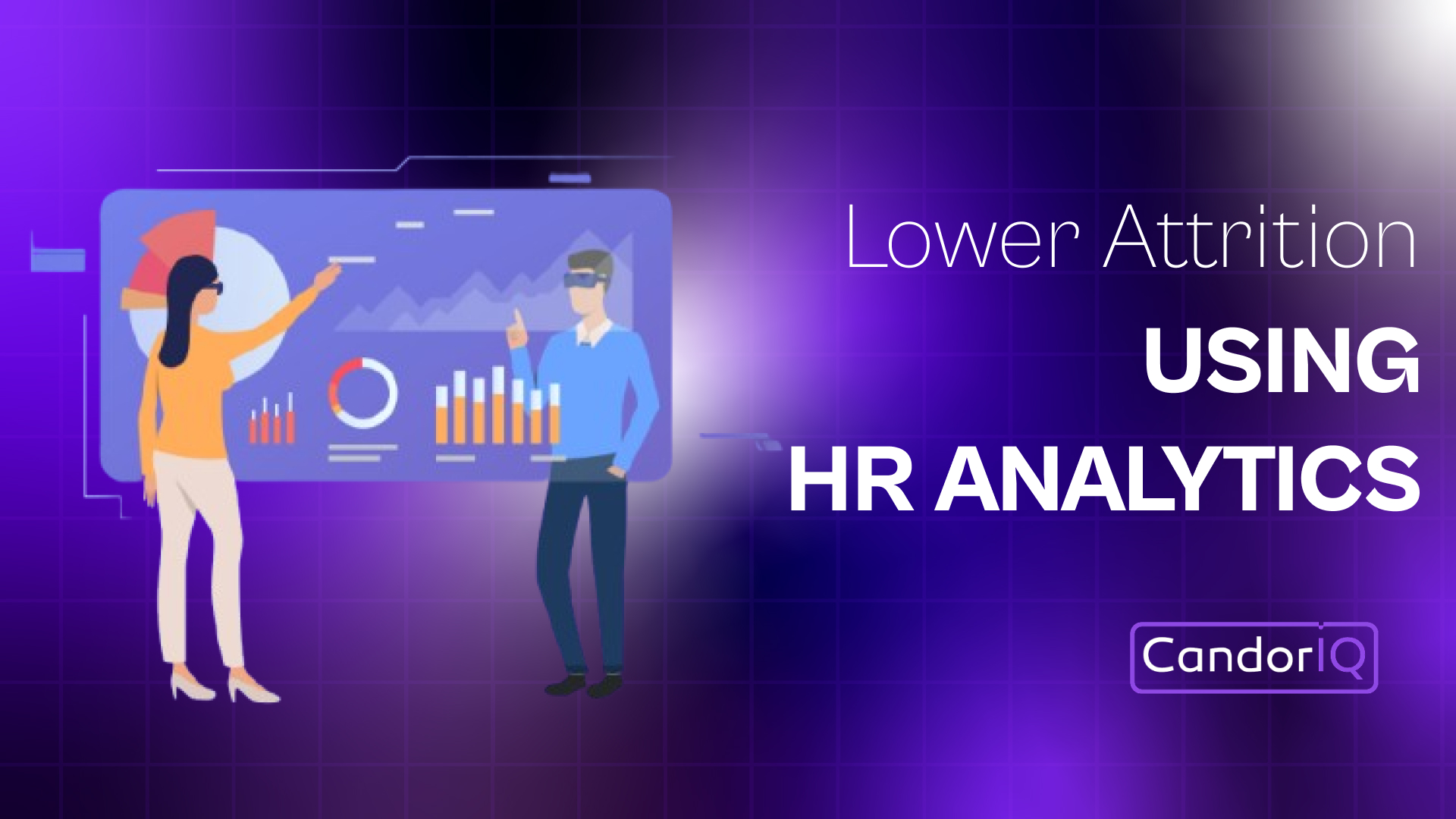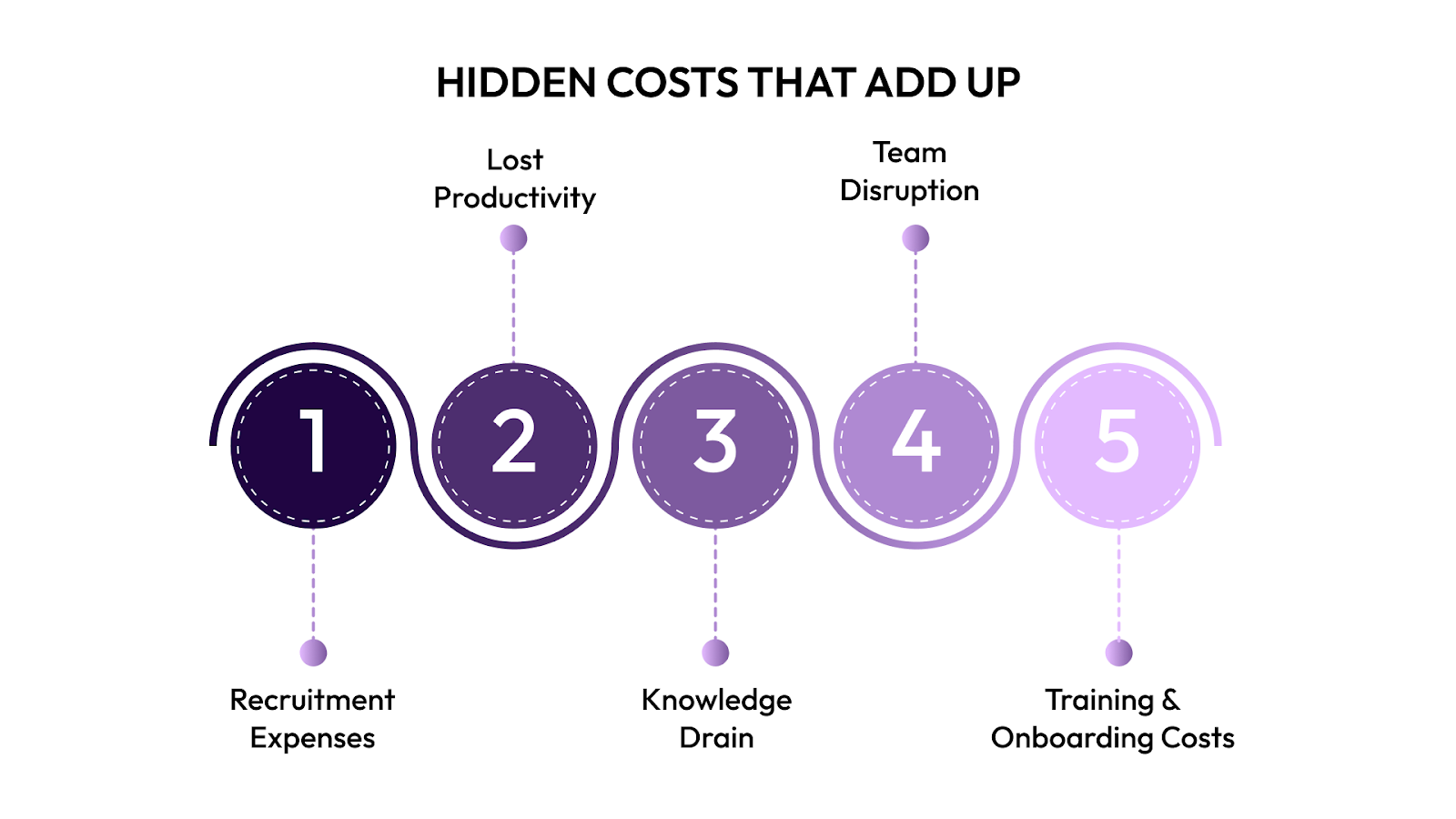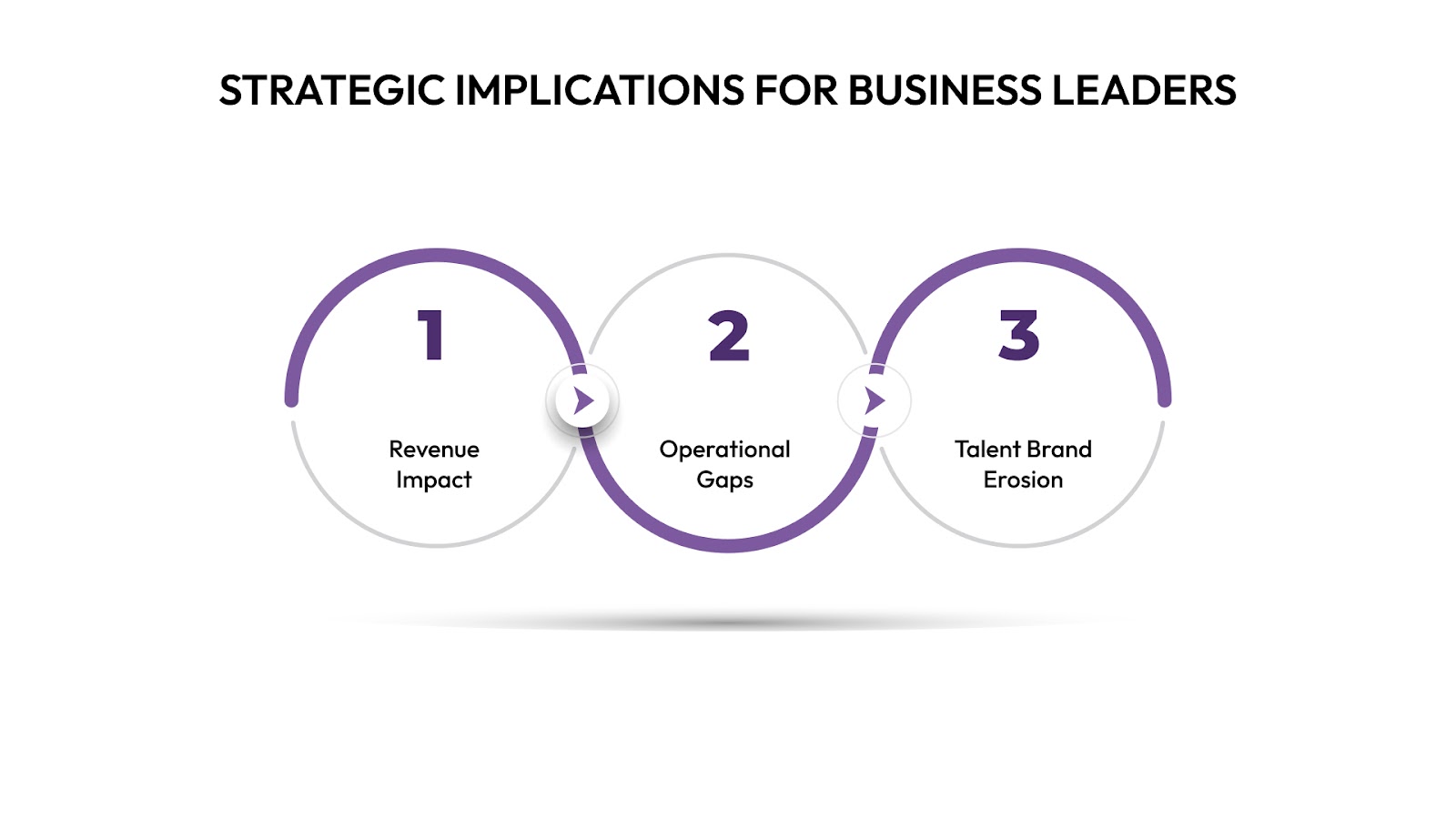Reduce Employee Attrition Using HR Analytics
Reduce employee attrition with HR analytics by predicting risks and creating data-driven strategies. Enhance retention and engagement now!

High-performing employees walking out the door? And it’s costing you more than just recruitment fees; attrition silently drains your productivity, morale, and margins.
Traditional exit interviews and gut-feel retention tactics no longer work. In today’s data-driven workplace, you need sharper tools. With HR Analytics, you can track patterns across performance, compensation, engagement, and tenure, and you can predict and prevent turnover before it happens.
In this article, you’ll discover how to reduce employee attrition with HR analytics, using actionable strategies that turn people data into business outcomes.
TL;DR:
- Employee attrition drains profits and momentum—predictive HR analytics helps stop it before it starts.
- Tools like CandorIQ use behavioral, compensation, and engagement data to flag high-risk departures early.
- Distributed teams face visibility gaps; real-time analytics close that loop and support smarter budget governance.
- Embedding attrition insights into compensation, headcount, and workflow decisions drives measurable retention impact.
- One SaaS firm cut regrettable attrition by 18% and saved $420K by integrating predictive analytics into daily operations.
The Cost of Employee Turnover
If you think employee attrition is just an HR issue, you need to think again. Turnover quietly erodes your profit margins, disrupts operational momentum, and delays growth, especially in fast-scaling organizations. This is particularly true for companies with 50 to 5,000 employees, where every departure has outsized impact and fewer layers to absorb disruption. Understanding the full financial and strategic impact is the first step to building a smarter retention strategy.
Hidden Costs That Add Up

Losing an employee isn’t just about posting a new job. It triggers a ripple effect across teams, timelines, and budgets:
- Recruitment Expenses: Job advertising, agency fees, background checks, and interview hours all add up.
- Lost Productivity: It takes an average of 6–9 months for a new hire to reach full productivity.
- Knowledge Drain: Departing employees often take institutional knowledge, customer relationships, or project momentum with them.
- Team Disruption: Turnover impacts morale, increases stress on remaining team members, and may trigger further exits.
- Training & Onboarding Costs: Ramp-up time and training investment are sunk costs if retention fails.
In fact, replacing an employee can cost anywhere from 50% to 200% of their annual salary, depending on the role's seniority and specialization.
Strategic Implications for Business Leaders

Beyond direct costs, attrition threatens your ability to execute long-term plans:
- Revenue Impact: Sales and client-facing roles often carry quota or customer responsibilities. Turnover in these areas can stall revenue generation.
- Operational Gaps: Critical functions like engineering, finance, or compliance may suffer delays or risk exposure when key personnel leave.
- Talent Brand Erosion: High turnover rates damage employer branding, making it harder to attract top-tier candidates.
Companies with high attrition see lower employee engagement, which directly correlates to reduced profitability.
Passive attrition is a strategic liability. Waiting for exit interviews or lagging retention reports won’t help you stay ahead. Instead, forward-looking companies are turning to HR analytics to reduce employee attrition, because preventing a departure is significantly more cost-effective than replacing one.
How HR Analytics Predicts Turnover
Most companies spot turnover only after the damage is done. But what if you could predict who’s likely to leave before they hand in their resignation? That’s exactly what HR analytics enables.
By analyzing behavioral, performance, and compensation patterns, you can shift from reactive retention to proactive talent strategy.
The Predictive Power of HR Analytics
HR analytics moves beyond basic reporting. It uses historical and real-time data to forecast attrition risks, flagging employees who may be considering an exit based on leading indicators.
Here’s how it works:
1. It Detects Early Warning Signs
People rarely leave without warning. Subtle behavioral shifts often precede resignations. HR analytics identifies these patterns with precision.
Common predictors include:
- Drop in engagement scores or survey participation,
- Increased absenteeism or late log-ins (in remote teams),
- Declining performance reviews or missed targets,
- Lack of internal mobility over time (stalled career paths),
- Pay gaps relative to peers in similar roles or geographies.
2. It Surfaces Compensation Imbalances
Undercompensation is one of the most consistent drivers of regrettable attrition. Analytics platforms benchmark salary and equity across levels, functions, and locations, helping you spot outliers before they become exit risks.
What you can uncover:
- Pay disparities between similar roles,
- Employees below the market rate in key locations,
- Inconsistent raise or bonus histories.
3. It Identifies Patterns Across Teams or Demographics
Attrition is rarely random. With HR analytics, you can uncover macro-level insights like:
- High turnover in specific departments or locations,
- Exit trends among early-tenure employees,
- Disengagement spikes after organizational changes or compensation cycles.
These insights allow you to deploy targeted interventions before attrition becomes systemic.
4. It Combines Multiple Data Sources for Context
To be effective, attrition predictions must draw from multiple data streams, including engagement, performance, compensation, headcount, tenure, and promotion history. This gives you context, not just correlation.
Integrated analysis enables you to:
- Model the financial impact of potential departures,
- Simulate retention scenarios (e.g., promotion vs. bonus vs. role change),
- Prioritize interventions for high-value talent.
As a business executive, you can’t afford to fly blind when it comes to talent risk. HR analytics provides the visibility and precision needed to reduce employee attrition strategically, not just logistically.
It turns your people's data into a competitive advantage that helps you protect institutional knowledge, improve workforce stability, and meet your business goals with greater confidence.
Key Analytics Strategies to Reduce Attrition
Knowing who’s likely to leave is just the start. The real impact comes from using that insight to retain top performers, stabilize high-risk teams, and build long-term workforce resilience.
Below are five analytics-backed strategies that help you proactively reduce employee attrition, with precision and measurable ROI.
1. Build Predictive Flight-Risk Models
Instead of waiting for resignation letters, use historical employee data to identify at-risk talent early.
How it works:
- Analyze patterns across performance reviews, tenure, comp changes, promotion history, and engagement scores.
- Apply scoring models to flag potential leavers, well before exit interviews.
- Refine the model quarterly based on real attrition outcomes.
2. Monitor Engagement and Sentiment Trends in Real Time
Engaged employees don’t leave, they grow. Disengagement, on the other hand, often starts silently. With the right analytics tools, you can monitor changes in sentiment before they escalate.
Key signals to track:
- eNPS score fluctuations,
- Drop in participation in surveys or all-hands meetings,
- Increase in absenteeism or unplanned leave,
- Manager feedback during 1:1 check-ins.
3. Audit Compensation Gaps and Benchmark Fairness
Pay remains a critical factor in turnover, especially among high-performing and high-potential employees. Use compensation analytics to catch red flags early.
Steps to take:
- Compare employee pay against internal peers and external benchmarks.
- Identify gender, geography, or function-based pay discrepancies.
- Review past raises and bonus cycles for patterns of neglect.
4. Analyze Onboarding and Ramp-Up Effectiveness
The first 90 days often determine whether a new hire stays beyond year one. Use analytics to evaluate the strength of your onboarding funnel.
Key metrics to track:
- Time-to-productivity by role and function,
- Retention rates within 6 months of hire,
- Early performance indicators (e.g., project completions, goal attainment),
- Manager satisfaction scores during onboarding.
5. Prioritize High-Value Talent with Targeted Retention Plans
Not all attrition carries equal weight. Use analytics to segment your workforce and prioritize retention efforts where the risk and cost is highest.
How to segment:
- Identify roles tied directly to revenue, IP, or client relationships.
- Score employees based on performance, potential, and risk.
- Create tailored retention packages: career pathing, stretch projects, equity refreshers, or leadership access.
Now that you understand the strategies, we’ll show you how to operationalize them using a unified analytics platform like CandorIQ, where insights turn into execution.
Integrating Analytics with Workflow Execution
Identifying attrition risk is only valuable if you act on it quickly and at scale. That’s why integrating HR analytics into your core workflows is essential. When insights flow directly into your compensation reviews, headcount approvals, and talent decisions, you move from data awareness to outcome delivery.
Why Integration Is a Strategic Advantage
Without workflow integration, analytics becomes another dashboard that never gets used. But when plugged into your operational rhythm, it enables real-time, cross-functional collaboration between HR, Finance, and leadership. For CFOs and FP&A leaders, this means gaining visibility into the financial impact of attrition and aligning workforce investments with budget strategy.
How to Operationalize Insights Across Your Organization
To reduce attrition effectively, insights must move beyond dashboards and into everyday decision-making.
Here’s how to embed predictive analytics into your workflows and turn visibility into action.
1. Connect Your Systems for Unified Visibility
Start by centralizing workforce data across platforms. CandorIQ pulls inputs from HRIS, ATS, payroll, and performance tools, allowing you to see compensation gaps, flight risks, and team health in one place.
Benefits:
- Eliminate data silos between HR and Finance.
- Build a unified source of truth for workforce decisions.
- Reduce manual reconciliation and versioning errors.
Audit your data connectors quarterly to ensure seamless sync across systems.
2. Embed Risk Insights into Compensation & Headcount Workflows
CandorIQ enables real-time execution by embedding attrition risk flags into the workflows where decisions happen, comp cycles, merit reviews, and headcount requests.
What this enables:
- Automatically flag at-risk employees during comp planning.
- Prioritize high-retention-impact roles in new headcount approvals.
- Route approvals are dynamically based on risk and business value.
3. Simulate Retention Scenarios with Financial Impact
Use CandorIQ’s scenario planning to compare the cost of turnover vs. targeted retention strategies. Model what-if cases: What happens if this team loses 2 high performers? What’s the ROI of a bonus vs. a promotion?
Use cases:
- Prioritize retention spend by risk-adjusted impact.
- Justify intervention budgets with clear cost-benefit logic.
- Align retention plans with CFO expectations.
4. Drive Accountability with Role-Specific Dashboards
Not every stakeholder needs the same view. With CandorIQ, you can configure custom dashboards for HRBPs, finance leaders, and department heads, ensuring they see relevant KPIs tied to their domain.
What this looks like:
- Finance sees comp trends and burn rate by team.
- HR sees attrition risk and engagement score changes.
- Managers see alerts tied to their direct reports.
The true value of HR analytics lies not in insights, but in action. By integrating analytics directly into your workforce planning and compensation processes, platforms like CandorIQ help you close the loop between data and decisions faster, smarter, and with measurable impact.
Measuring Success: Metrics That Matter
To justify continued investment in retention initiatives, you need clear, measurable outcomes. That means going beyond gut feel and tracking KPIs that directly connect employee stability to business performance. The right metrics not only validate your strategy—they help you course-correct early and scale what works.
Why It Matters
Retention strategies without measurement are guesswork. When you quantify success, you can:
- Prove ROI to the C-suite and board.
- Prioritize retention tactics by business impact.
- Spot emerging attrition trends before they escalate.
Essential Metrics to Track

1. Overall Attrition Rate
This baseline figure tells you what percentage of your workforce exits over a defined period.
Formula: Total voluntary separations ÷ average headcount × 100
2. Regrettable Turnover Rate
Focus on the people you didn't want to lose—high performers, critical roles, or future leaders.
This rate isolates high-cost departures that affect morale, client continuity, or project execution.
Target: Keep regrettable turnover under 5% in strategic functions.
3. Flight Risk Accuracy
Track how well your predictive models flagged employees who actually left.
What to measure:
- Percentage of flagged employees who exited within 90 days.
- False positives vs. true positives in your risk model.
4. Cost Avoided from Retention Interventions
Estimate the savings from retaining employees who would otherwise have left.
How to calculate:
- Estimate cost to replace (typically 50–200% of annual salary).
- Multiply by the number of high-risk employees retained post-intervention.
5. Time-to-Productivity for New Hires
Retention isn’t just about who stays; it’s about how fast new hires ramp up.
Track:
- Average time to reach full performance by role.
- Productivity milestones within the first 90–180 days.
6. Engagement & Satisfaction Shifts
Measure how well your efforts are improving the employee experience.
Key indicators:
- eNPS (Employee Net Promoter Score).
- Pulse survey participation and sentiment.
- Qualitative feedback via exit and stay interviews.
Use platforms like CandorIQ to track these metrics in real time, across functions and geographies. With customizable dashboards, you can give HR, Finance, and leadership teams role-specific insights tied directly to attrition and retention goals.
Schedule quarterly reviews of these KPIs, link them to comp and workforce planning outcomes, and refine your retention strategy accordingly.
Case Study Snapshot: Cutting Regrettable Attrition by 18% with CandorIQ
Sometimes the best proof of concept is a real-world result. Here’s how a fast-growing B2B SaaS company used HR analytics via CandorIQ to proactively reduce employee attrition, without bloating budgets or slowing down hiring velocity.
Company Profile
- Industry: SaaS (Enterprise Collaboration Tools)
- Team Size: 350 employees across North America, EMEA, and APAC
- Stage: Series C, growing at 2.5x YoY
- Problem: Spike in regrettable attrition in Engineering and Customer Success
- Goal: Identify flight risks early and improve retention of key talent by 15%
The Challenge
Despite offering competitive compensation, the company was losing top performers faster than it could replace them. Exit interviews cited career stagnation and compensation uncertainty as key drivers, but feedback was too little, too late.
Pain points:
- No centralized visibility into pay disparities or promotion bottlenecks.
- Managers lacked real-time signals on disengaged team members.
- Compensation cycle decisions were reactive and spreadsheet-based.
Over a 6-month period, attrition in Engineering roles reached 22%, nearly double the company’s target.
The Solution with CandorIQ
The company implemented CandorIQ to unify compensation and headcount planning with predictive analytics for employee retention.
Key steps taken:
- Flight Risk Modeling: CandorIQ’s AI flagged at-risk employees based on engagement drop-offs, missed promotions, and relative compensation benchmarks.
- Pay Equity Audits: HR used CandorIQ to identify role- and region-specific pay gaps and made equity adjustments before the next merit cycle.
- Targeted Retention Plans: Business leaders implemented a mix of stretch assignments, early promotion reviews, and equity refreshers for flagged employees.
- Workflow Integration: Risk alerts were embedded directly into compensation and headcount approval processes, keeping managers informed at decision points.
Results Achieved
- 18% reduction in regrettable attrition across Engineering and Customer Success.
- $420,000 in turnover-related cost savings, based on avoided replacement and ramp-up costs.
- 6% increase in employee satisfaction scores among at-risk cohorts.
- Comp cycle completion time reduced by 40%, with embedded analytics and approval automation.
This company didn’t need more people; they needed better visibility and action at the right time. With CandorIQ, they transformed HR analytics from a reporting tool into a retention engine.
You can do the same. Start by identifying the roles you can’t afford to lose, and let data guide how you keep them.
Best Practices & Next Steps
Successfully reducing employee attrition with HR analytics requires more than dashboards; it takes strategic alignment, operational discipline, and stakeholder buy-in.
Here are five best practices to ensure your analytics-driven retention efforts generate results that matter.
1. Build a Unified Data Foundation: Break down data silos between HR, Finance, and Operations by integrating your HRIS, ATS, compensation, and performance systems. Use a centralized platform like CandorIQ to ensure a single source of truth across teams.
2. Prioritize Predictive Over Reactive: Don’t wait for resignations to diagnose problems. Focus on forward-looking indicators such as engagement trends, compensation gaps, and internal mobility stalls.
3. Embed Insights into Daily Workflows: Ensure managers and business leaders receive real-time signals during planning cycles, not as postmortem reports. Configure workflow-integrated alerts for high-risk roles within your compensation and headcount planning tools.
4. Segment and Target Interventions: Not all turnover is equally costly. Focus retention efforts on top performers, critical roles, and teams with high business impact.
5. Review, Refine, and Report Quarterly: Measure your flight-risk accuracy, intervention outcomes, and cost avoidance, then adjust your models and messaging. Share tailored dashboards with HR, Finance, and Exec teams to ensure accountability and alignment.
Conclusion
Reducing employee attrition isn’t just an HR win; it’s a business advantage. When you harness the right analytics, you shift from reacting to resignations to preventing them. From identifying flight risks early to aligning compensation and career paths with employee expectations, HR analytics empowers you to protect your top talent, preserve institutional knowledge, and support long-term growth.
But insight alone isn’t enough; you need execution. CandorIQ gives you both. Our platform combines real-time analytics with workflow automation to help you predict, prevent, and reduce employee attrition with clarity and confidence.
Request a demo today and see how CandorIQ turns workforce data into measurable retention outcomes.


